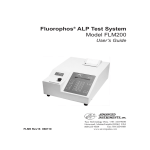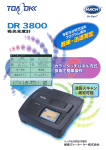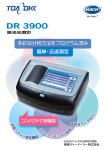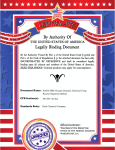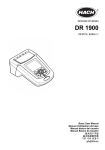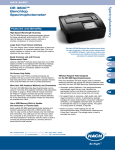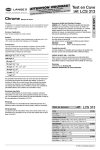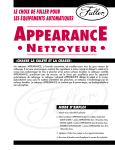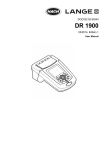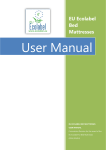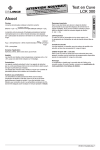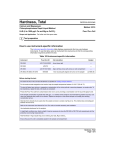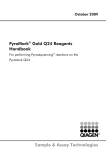Download Ultra Low Range Total and Reactive Phosphorus for use with
Transcript
APPLICATION NOTE ULTRA LOW RANGE TOTAL AND REACTIVE PHOSPHORUS (FOR USE WITH DR 2700, DR 2800, DR 3800, DR 3900 AND DR 5000 HACH SPECTROPHOTOMETER) Phosphorus, Total and Reactive (Orthophosphate) Method 10209 Reactive; Method 10210 Total (TNT 843) Hach offers total and reactive phosphorus methods using the Hach’s TNTplus reagents for UHR (2 to 20 mg/L PO4-P, TNT 844), HR (0.5 to 5.0 mg/L PO4-P, TNT 844) and LR (0.05 to 1.5 mg/L PO4-P, TNT 843). However; the detection limit for the LR method is 50 µg/L, which may be too high for some state’s nutrient standards plans to limit surface water eutrophication. This application note will describe how to achieve a low-end reporting limit of 10 µg/L PO4-P, with a calculated statistical method detection limit (MDL) of 4.95 µg/L PO4-P for reactive phosphorus and 5.35 µg/L PO4-P for total phosphorus. The concentration range for this application is 10 to 500 µg/L PO4-P. Equipment needed for this application: 1) TNT 843, TNTplus phosphorus reagents 2) DRB200 Digital Reactor Block for TNTplus with 13 mm vial wells 3) 5-cm semi micro cuvette, PN LZP341 Enter User Program: Follow the DR spectrophotometer’s user manual to set up a user-entered program. Enter these values into the user enter program: Units = µg/L Wavelength = 880 nm Resolution = 1 Chemical Form 1 = PO4-P Chemical Form 2 = PO4, Factor = 3.066 Calibration: select enter formula – select the quadratic formula (C = a + bA + cA2), a = -47.7, b = 283, c = 8.95 *(see calibration formulas at the end of the application note) Timer 1 = 10.0 minutes Procedure: Total phosphorus Follow method 10210 for the determination of total phosphorus using the TNTplus™ 843 reagent vials. Digestion and Analysis: 1. Turn on the DRB200 Reactor and set temperature to 100°C 2. Carefully remove the foil from the DosiCap™ Zip. Unscrew the cap from the vial. 3. Carefully pipet 3.5 mL of sample into the vial. This is the main difference between the standard procedure for method 10210 and this ULR method. 4. Flip the DosiCap™ Zip over so the reagent side faces the vial. Screw the cap tightly onto the vial. 5. Shake the capped vial 2 – 3 times to dissolve the reagent in the cap. 6. Insert the vial in the DRB 200 Reactor and heat for 1 hour at 100°C. 7. After the digestion time expires, carefully remove the hot vial from the reactor and allow it to cool to room temperature in a test tube rack. 8. Pipet 0.2 mL of Reagent B into the cooled vial. 9. Screw a grey DosiCap C onto the vial. Invert the capped vial 2 – 3 times to dissolve the reagent in the DosiCap. 10. Wait 10 minutes for color development. 11. When the timer expires, invert the vial again 2 – 3 times. 12. Zero the spectrophotometer with a blank. To zero the spectrophotometer, fill a 5-cm semi-micro plastic cuvette with DI water* and press the ‘zero’ key. Thoroughly clean the outside of the cuvette and make sure there are no air bubbles in the light path. For the most accurate results, zero with the same cuvette that you analyze the sample with. 13. Transfer the reacted sample from the TNTplus vial to the 5-cm semi-micro plastic cuvette. Again, ensure that the cuvette is clean on the sides where the light passes through, place the cuvette into the spectrophotometer and press ‘read’. Procedure: Reactive, orthophosphate Follow method 10209 for the determination of reactive phosphorus using the TNTplus™ 843 reagent vials. Analysis: 1. Carefully pipet 3.5 mL of sample into the vial. This is the main difference between the standard procedure for method 10210 and this ULR method. 2. Pipet 0.2 mL of Reagent B into the cooled vial. 3. Screw a grey DosiCap C onto the vial. Invert the capped vial 2 – 3 times to dissolve the reagent in the DosiCap. 4. Wait 10 minutes for color development. 5. When the timer expires, invert the vial again 2 – 3 times. 6. Zero the spectrophotometer with a blank. To zero the spectrophotometer, fill a 5-cm semi-micro plastic cuvette with DI water* and press the ‘zero’ key. Thoroughly clean the outside of the cuvette and make sure there are no air bubbles in the light path. For the most accurate results, zero with the same cuvette that you analyze the sample with. 7. Transfer the reacted sample from the TNTplus vial to the 5-cm semi-micro plastic cuvette. Again, ensure that the cuvette is clean on the sides where the light passes through, place the cuvette into the spectrophotometer and press ‘read’. Support Data: Precision Study Standard OP- 200 µg/L TP - 200 µg/L Average 195 µg/L 195 µg/L Standard Deviation 1.83 1.71 % RSD 0.94 0.87 Average 8.43 µg/L 12.7 µg/L Standard Deviation 1.87 1.70 MDL 4.95 5.35 Ten replicates were analyzed MDL Study Standard OP - 10 µg/L TP - 10 µg/L Seven replicates were analyzed Reactive Phosphorus Spikes Sample DI Water Drinking Water 1 Drinking Water 2 Unspiked 0.0 0.0 57 Spiked Concentration (200 µg/L) 188 187 253 % Recovery 94 93.5 98 Two replicates of drinking / DI water spiked samples were analyzed along with one unspiked drinking / DI water sample Total Phosphorus Spikes with Orthophosphorus Spiked Concentration Sample Unspiked (200 µg/L) DI Water 3.0 191 Drinking Water 1 3.0 190 Drinking Water 2 62 255 % Recovery 94 93.5 96.5 Two replicates of drinking / DI water spiked samples were analyzed along with one unspiked drinking / DI water sample Total Phosphorus Spikes with Trimethylphosphate Spiked Concentration Sample Unspiked (200 µg/L) DI Water 0 203 Drinking Water 1 3 206 Drinking Water 2 62 268 % Recovery 101.5 101.5 103 Two replicates of drinking / DI water spiked samples were analyzed along with one unspiked drinking / DI water sample Total Phosphorus Spikes with Phenylphosphate Spiked Concentration Sample Unspiked (200 µg/L) DI Water 0 212 Drinking Water 1 3 212 Drinking Water 2 62 267 % Recovery 106 104.5 102.5 Two replicates of drinking / DI water spiked samples were analyzed along with one unspiked drinking / DI water sample Total Phosphorus Spikes with Sodium pyrophosphate Spiked Concentration Sample Unspiked (200 µg/L) DI Water 0 186 Drinking Water 1 3 190 Drinking Water 2 62 268 % Recovery 93 93.5 103 Two replicates of drinking / DI water spiked samples were analyzed along with one unspiked drinking / DI water sample Total Phosphorus Spikes with Sodium tripolyphosphate Spiked Concentration Sample Unspiked (200 µg/L) DI Water 0 213 Drinking Water 1 3 218 Drinking Water 2 62 275 % Recovery 106.5 107.5 106.5 Two replicates of drinking / DI water spiked samples were analyzed along with one unspiked drinking / DI water sample * Calibration Formulas There is another calibration equation that can be used for this application. The calibration formula listed above is to be used when zeroing on DI water. This calibration equation includes the reagent blank (DI water used as the sample) in the calibration curve; which is why there is a large offset (y-intercept). If you want to zero the photometer on the reagent blank, with the reagent blank in the calibration curve, it is recommended to use the following calibration formula: Calibration: select enter formula – select the quadratic formula (C = a + bA + cA2), a = -2.74, b = 286, c = 8.96 When using this calibration formula, you need to make sure that you zero on the reagent blank and not on DI water. HACH COMPANY WORLD HEADQUARTERS Telephone: (970) 669-3050 FAX: (970) 669-2932 FOR TECHNICAL ASSISTANCE, PRICE INFORMATION AND ORDERING: Call 800-227-4224 Contact the HACH office or distributor serving you. www.hach.com [email protected] LIT2097 L11 Printed in U.S.A ©Hach Company, 2011. All rights reserved. In the interest of improving and updating its equipment, Hach Company reserves the right to alter specifications to equipment at any time.





